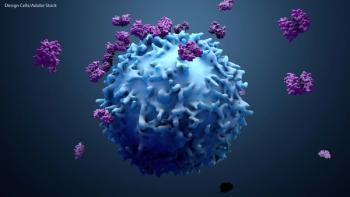
Vorasidenib Improves PFS, Shows Tumor Reduction in IDH1/2+ Glioma
Treatment with vorasidenib also confers better seizure control than placebo in the phase 3 INDIGO study.
Compared with placebo, vorasidenib (Voranigo) yielded improvements in progression-free survival and tumor shrinkage among those with diffuse glioma harboring IDH1/2 mutations, according to findings from the phase 3 INDIGO trial (NCT04164901) presented at the 2024 Society for Neuro-Oncology (SNO) Annual Meeting.1
At a median follow-up of 20.1 months, and a data cutoff date of March 7, 2023, the median progression-free survival (PFS) with vorasidenib (n = 168) was not estimable (NE; 95% CI, 22.1-NE) by blinded independent review committee (BICR) assessment vs 11.4 months (95% CI, 11.1-13.9) with placebo (n = 163), translating to a 65% reduction in the risk of disease progression or death (HR, 0.35; 95% CI, 0.25-0.49; P = .00000000013). The longer follow-up confirmed the statistically significant improved PFS observed at the time of the second interim analysis (IA2), which had a data cutoff date of September 2022 (HR, 0.39; 95% CI, 0.27-0.56).2
The longer follow-up also confirmed that vorasidenib improves time to next intervention (TTNI) vs placebo (IA2: HR, 0.26; 95% CI, 0.15-0.43).1,2 The median TTNI with vorasidenib was NE (95% CI, NE-NE) vs 20.1 months (95% CI, 17.5-27.1) with placebo (HR, 0.25; 95% CI, 0.16-0.40; P = .000000000048).1
Evaluable patients who received vorasidenib (n = 167) experienced a lower seizure rate than those who had not (n = 163), with total numbers of on-treatment seizure events of 1541 vs 5124, respectively. The respective rates of on-treatment seizures per person-year were 18.2% (95% CI, 8.4%-39.5%) and 51.2% (95% CI, 22.9%-114.8%), respectively (ratio of rates, 0.36; 95% CI, 0.14-0.89; 2-sided P = .0263). Lastly, vorasidenib proved to lead to reductions in tumor volume (–1.3% [95% CI, –3.2% to 0.7%]) as volume continued to increase with placebo (14.4% [95% CI, 12.0%-16.8%]), which translated to a 15.9% difference (95% CI, 12.6%-19.3%; P < .001) between the slopes.
“In summary, with 6 months of additional follow-up, vorasidenib showed robust efficacy, with greater magnitude of PFS and a reduction in tumor volume [than placebo,]” Ingo K. Mellinghoff, MD, FACP, of Memorial Sloan Kettering Cancer Center (MSKCC) in New York City, NY, said in a presentation of the data.1 “No additional safety signals [were observed]. Vorasidenib [was also] associated with better seizure control [than placebo].” Mellinghoff is the chair of the Department of Neurology, the chief of Brain Tumor Service, and the Evinin Family Chair in Neuro-Oncology, at MSKCC.
Vorasidenib is an oral inhibitor of mutant IDH1 and IDH2 that was designed to achieve brain penetrance. The agent has been found to reduce tumor concentrations of 2-HG by over 90% in resected grade 2 or 3 non-enhancing diffuse glioma, according to Mellinghoff. He explained that a reduction in 2-HG has been linked with lower tumor cell proliferation, reversal of IDH1/2 mutation–associated gene expression programs, and increased DNA 5-hydroxy-methylcytosine as well as tumor-infiltrating lymphocytes.
Investigators of the INDIGO trial enrolled patients with IDH1/2-mutated grade 2 oligodendroglioma or astrocytoma per 2016 World Health Organization guidelines who were at least 12 years of age and who had undergone at least 1 prior surgery for glioma. To be eligible, patients had to have measurable non-enhancing disease, defined as having at least 1 target lesion measuring at least 1 cm by at least 1 cm, that was confirmed by BIRC. If they required immediate chemotherapy or radiotherapy per investigator assessment, they were not included.
Study participants (n = 331) were randomly assigned 1:1 to receive 40 mg of oral vorasidenib or placebo once daily in 28-day cycles. Notably, centrally confirmed disease progression allowed for unblinding and crossover.
In addition to the primary end point of PFS by BIRC assessment and the key secondary end point of TTNI, other secondary end points included tumor growth rate (TGR) by volume, safety, and health-related quality of life (FACT-Br). Exploratory end points comprised pre- and post-crossover TGR, pre- and -post-treatment TGR, neurocognitive function, and seizure activity.
Enrollment began in January 2020 and completed in February 2022. IA2 data were shared at the 2023 ASCO Annual Meeting and had a median follow-up of 14.2 months with a data cutoff date of September 6, 2022. The earlier findings from the study supported the August 2024 FDA approval of vorasidenib in adult and pediatric patients aged 12 years and older with grade 2 astrocytoma or oligodendroglioma with a susceptible IDH1 or IDH2 mutation, after surgery including biopsy, subtotal resection, or gross total resection.3
The study was unblinded at the most current data cutoff date of March 7, 2023, and longer-term findings were shared at this year’s SNO meeting.1 The median follow-up for vorasidenib and placebo was 19.8 months and 20.2 months, respectively. At the time of data cutoff, 99.4% of patients on the vorasidenib arm received treatment vs 100% of those on the placebo arm; 73.2% and 44.2% of patients were still on treatment. In the vorasidenib arm, 26.2% had discontinued treatment due to disease progression (18.5%), patient decision (3.0%), toxicity (4.2%), or investigator decision (0.6%). Seven total patients had discontinued the study due to patient decision (n = 6) or death (n = 1), which was not determined to be related to study treatment. Notably, no patients were lost to overall survival follow-up, according to Mellinghoff.
Notably, the PFS benefit provided with vorasidenib vs placebo proved to be consistent across all subgroups analyzed.
In a subgroup analysis, investigators evaluated TGR by BICR before and after starting treatment. They found that tumor volume increased in patients before receiving vorasidenib and decreased afterward. The pre-treatment rate in this arm was 13.4% (95% CI, 10.5%-16.4%) vs –3.2% (95% CI, –4.8% to –1.7%) post-treatment; in the placebo arm, these respective rates were 19.7% (95% CI, 16.4%-23.1%) and 11.1% (95% CI, 9.2%-13.1%). The percentage difference of slope change was 8.7% (95% CI, 3.1%-14.6%; P = .002).
Investigators also examined TGR by BICR before and after crossover and found that tumor volume decreased after patients on the placebo arm crossed over to receive vorasidenib. The TGR before crossover (n = 61) was 23.9% (95% CI, 19.0%-29.0%) vs 0.9% (95% CI, –3.6% to 5.6%) after crossover (n = 61), translating to a difference of –18.6% (95% CI, –23.4% to –13.5%) between slopes (P < .001). Notably, the median treatment duration for those who crossed over to vorasidenib was 6.8 months.
Data from an ad hoc analysis revealed that vorasidenib improved PFS over placebo irrespective of tumor volume at baseline (log baseline tumor volume up to 8: HR, 0.38; 95% CI, 0.17-0.86; log tumor volume greater than 8 but no greater than 10: HR, 0.37; 95% CI, 0.24-0.56; log tumor volume greater than 10: HR, 0.30; 95% CI, 0.14-0.69). Another subgroup analysis showed that vorasidenib improved PFS over placebo irrespective of pre-treatment TGR (under 4 mm/year: HR, 0.40; 95% CI, 0.19-0.85; 4 to less than 8 mm/year: HR, 0.43; 95% CI, 0.18-1.05).
The safety profile of vorasidenib was consistent after 6 months of additional follow-up. Any-grade treatment-emergent adverse effects (TEAEs) were experienced by 98.8% of those in the vorasidenib arm (n = 167) vs 95.1% of those in the placebo arm (n = 163); these effects were grade 3 or higher for 26.9% and 16.0% of patients, respectively.
Grade 3 or higher TEAEs included increased alanine aminotransferase (vorasidenib, 10.2%; placebo, 1.2%), increased aspartate aminotransferase (4.8%; 0%), seizure (4.2%; 3.1%), and increased gamma-glutamyltransferase (3.0%; 1.2%). In the vorasidenib arm, dose reduction and treatment interruptions due to TEAEs were needed by 11.4% and 32.9% of patients, respectively; these respective rates were 4.3% and 25.2% of patients in the placebo arm. Moreover, 4.2% of patients who received vorasidenib experienced TEAEs that led to treatment discontinuation vs 1.2% of those given placebo. Notably, no TEAEs proved fatal.
In addition to its approval in the United States, vorasidenib is also approved for grade 2 IDH1/2-mutated astrocytoma and oligodendroglioma in Canada, Australia, and the Middle East and Switzerland, Mellinghoff concluded. He added that registrations for the drug in this population are ongoing in Europe and other countries.
Disclosures: Mellinghoff disclosed serving in a consulting role for Agios Pharmaceuticals, Inc., AbbVie, Black Diamond Therapeutics, Erasca, F. Hoffman-La Roche, Novartis, Prelude Therapeutics, Servier Pharmaceutics LLC, and Voyager Therapeutics, Inc. He also shared that he receives support for attending an advisory board for DC Europa Ltd, and participates as an on-site principal investigator for Eli Lilly, Kazia Therapeutics Limited, Samus Therapeutics, Tango, and Vigeo Therapeutics.
References
- Mellinghoff IK, van den Bent MJ, Touat M, et al. A global, randomized, double-blinded, phase 3 study of vorasidenib versus placebo in patients with adult-type diffuse glioma with an IDH1/2 mutation (INDIGO): UPDATED RESULTS. Presented at: Presented at: 2024 SNO Annual Meeting; November 21-24, 2024; Houston, TX. CTNI-53.
- Mellinghoff IK, van den Bent MJ, Blumenthal DT, et al. INDIGO: A global, randomized, double-blinded, phase 3 study of vorasidenib versus placebo in patients with residual or recurrent grade 2 glioma with an IDH1/2 mutation. J Clin Oncol. 2023;41(suppl 17):LBA1. doi:10.1200/JCO.2023.41.17_suppl.LBA1
- FDA approves vorasidenib for Grade 2 astrocytoma or oligodendroglioma with a susceptible IDH1 or IDH2 mutation. FDA. August 6, 2024. Accessed November 23, 2024. https://www.fda.gov/drugs/resources-information-approved-drugs/fda-approves-vorasidenib-grade-2-astrocytoma-or-oligodendroglioma-susceptible-idh1-or-idh2-mutation
Newsletter
Stay up to date on recent advances in the multidisciplinary approach to cancer.


















































































